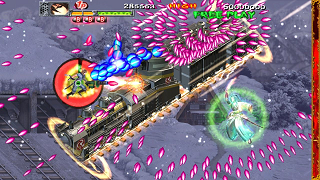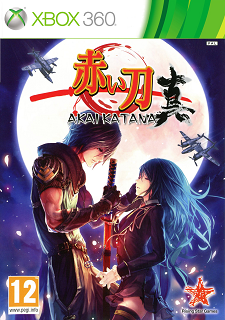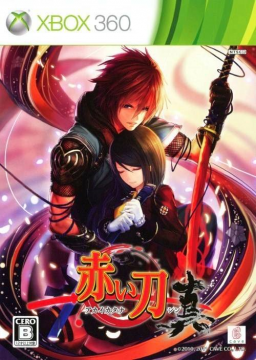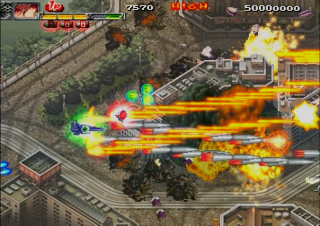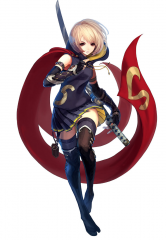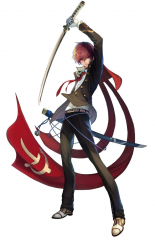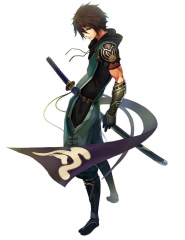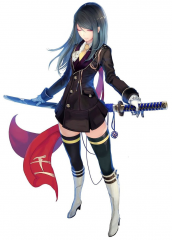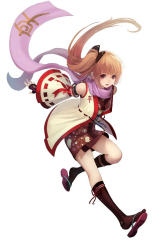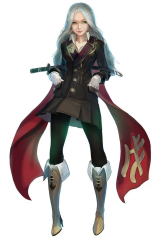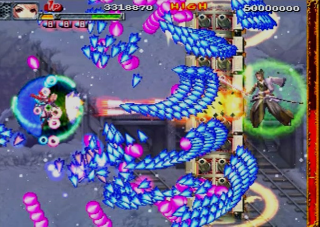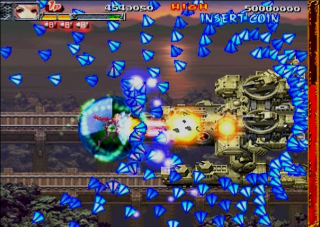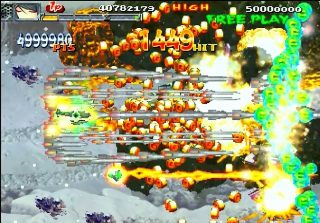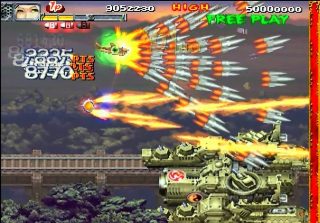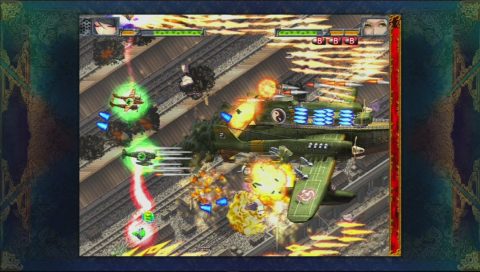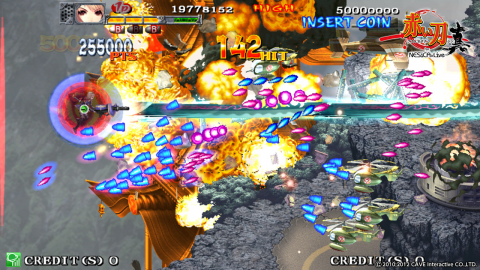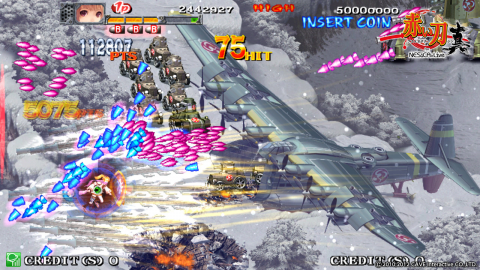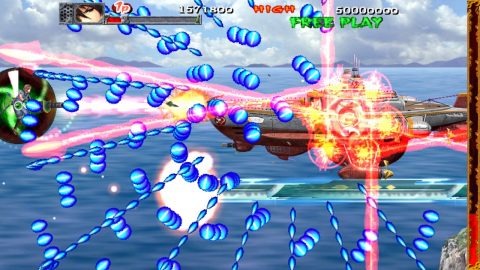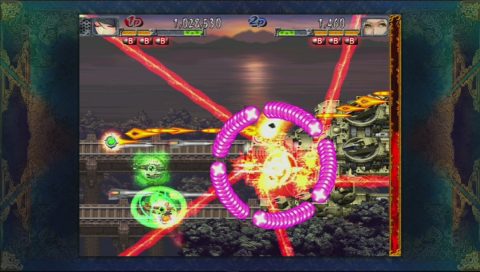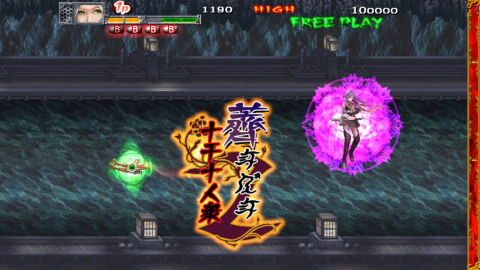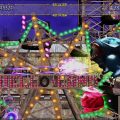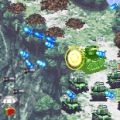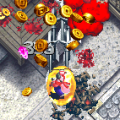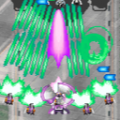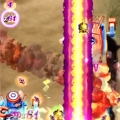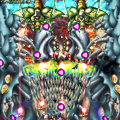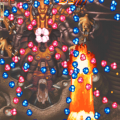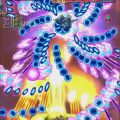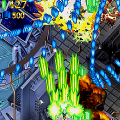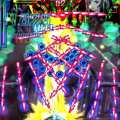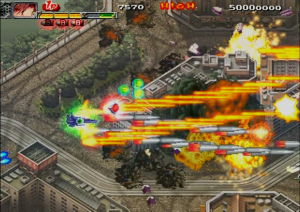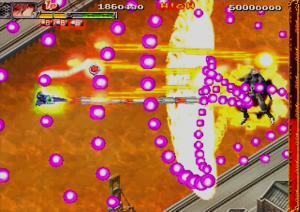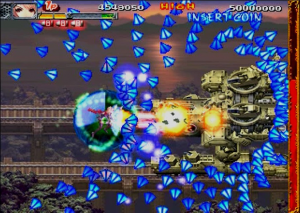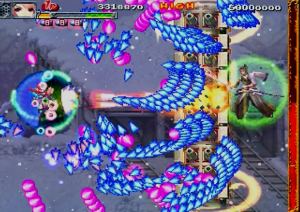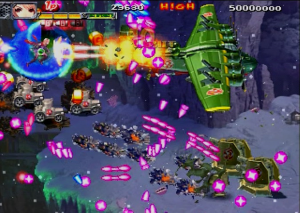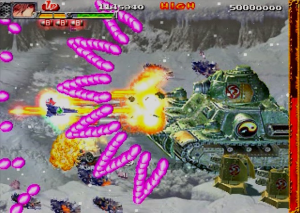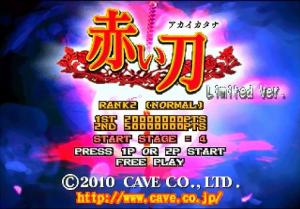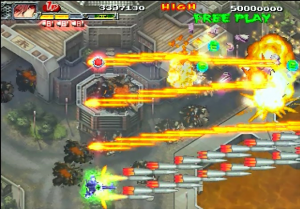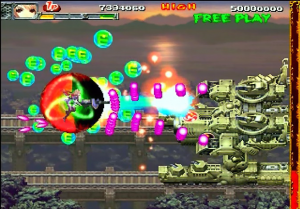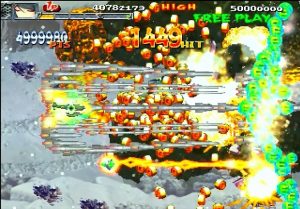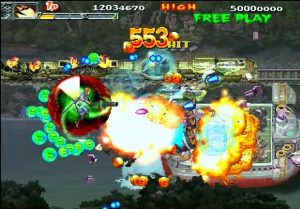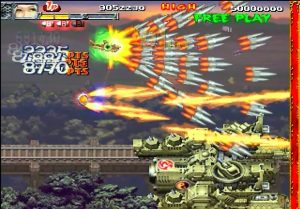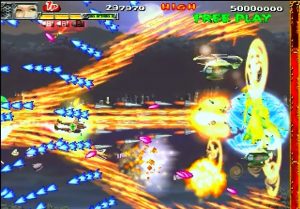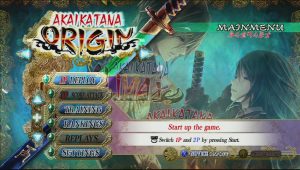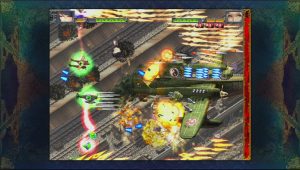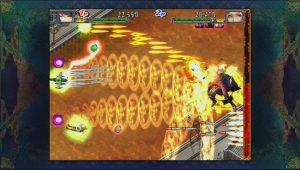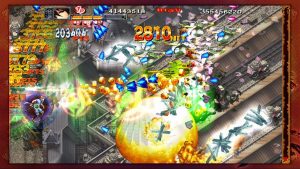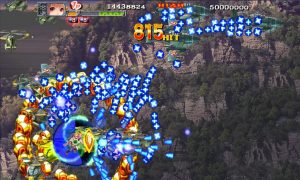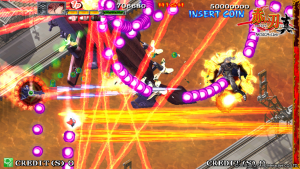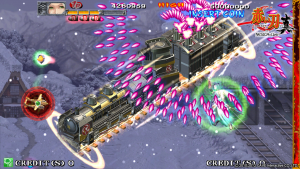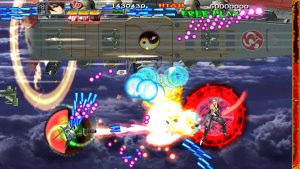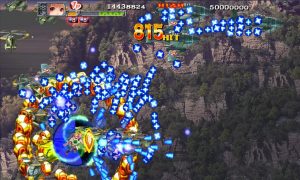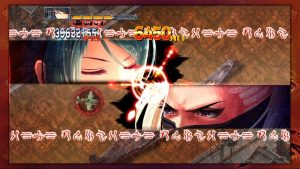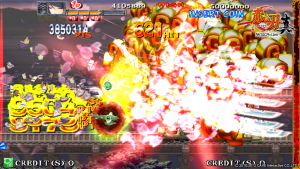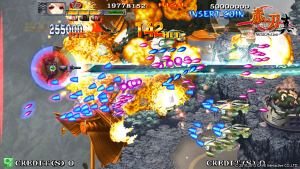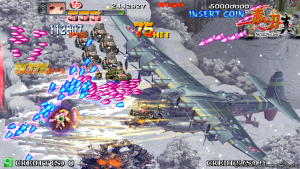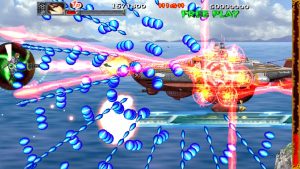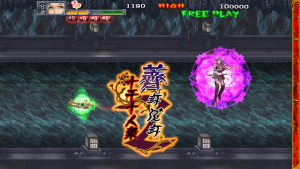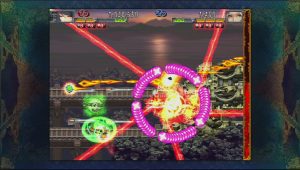Huge Ninjas Fighting Against Huge Battleships
In 2008, Cave released DoDonPachi Dai-Fukkatsu into Japanese arcades. The game was to be a “Grand Resurrection” of the DoDonPachi series, and was met with high praise from fans. So how could Cave possibly top a grand resurrection of their flagship series? It’s unclear, but making a game where ninjas fought against other ninjas throwing huge battleships at each other is certainly a good start. That game would go on to become Akai Katana (lit. Red Sword), and it ran on the CV1000-D version of the SH3 hardware, which was first used with DoDonPachi Dai-Fukkatsu. The CV1000-D is the same hardware as Cave’s regular SH3 hardware, but featured more ram than its predecessor. Akai Katana was directed by Shinobu Yagawa, a former employee of Raizing, and creator of cult classics such as Summer Carnival ’92: Recca , Battle Garegga, and Armed Police Batrider. Set in a parallel version of modern Japan, Akai Katana aimed to create a world that would have battleship-throwing ninjas seem believable and not out of place, in addition to having it be a fun game to play, and Cave certainly succeeded on that front.
As far as the story goes, it takes place in the Taisho era, an age mirroring the years of the industrial expansion in Japan, full of hope for reconstruction. Amidst record-breaking economic growth and technical innovation, the people of this era discovered a new energy source: a mineral called Guiding Ore which acted as a perfect substitute for coal and electricity. Besides its properties as a powerful natural resource, this Guiding Ore held other mysterious qualities. It could be tempered into a blade that the military called a “Guiding Katana”, which endowed certain soldiers who bore unique emblems with unique psychic powers. It was said that once this katana killed another human being, it would turn blood-red and endow its owner with an incredible power. It was this power that the Emperor Basho used to protect and expand the reach of his small country. He waged war on neighboring countries with an elite battalion who wielded the so-called “Blood Katanas”. This squadron was known as the Ten Suns and their name was hated across the land. The Emperor empowered them to “expand the reach of the Empire, even if it demands sacrifices.”
However, cracks soon appeared in the squad as those set against these dictatorial actions split into their own group. The rebels denounced the existing order and staged a revolt. The son of the Emperor Basho, Kikyou Saionji, was at the center of rebellion. Deploying in three devastating fighter-craft known as Shakevolts, secret weapons of the rebel battalion, Kikyou and his allies used their Guiding Katanas to begin in a mystic ceremony… one that would sacrifice one of these pilots in order to summon an immense power. Just as the Empire had done, Kikyou’s battalion would create their own Blood Katanas. Swallowing their bitters tears, the pilots of these ships swore victory against the Empire. And so the first page was turned in a great struggle between justice and tyranny.
Characters
Sumire Asaka
Age: 18 Zodiac: Yi (Wood, Yin)
A younger officer of Tsubaki who chose to sacrifice her life to become a phantom. Killed by her co-pilot Tsubaki, she offered her soul to a Blood Katana. Without a family to call her own, she was raised and instructed in warfare by the Imperial Officer Hiiragi.
Tsubaki Shinjo
Age: 19 Zodiac: Jia (Wood, Yang)
Originally a member of the Ten Suns, Tsubaki raised the banner of rebellion against the arrogant actions of the Empire. Tsubaki took the life of her junior officer, Sumire, to become the “guide” for the Blood Katana which held her soul. To forget the mistakes of her past, Tsubaki has given up living as a woman, and now dresses like a man.
Kikyou Saionji
Age: 22 Zodiac: Bing (Fire, Yang)
Kikyou’s mother, Sakura, was killed by his father, the emperor Basho. Although he was originally a top member of the Ten Suns, once Kikyou learned the truth behind the blood katanas, he started a rebellion against the Empire. To end the killing of innocents and to destroy the father who took his mother’s life, Kikyou sacrificed himself to a blood katana, so that it could be turned against the Empire. His beloved sister Botan took his life, which transformed him into a phantom more powerful than his human form could ever be.
Botan Saionji
Age 18 Zodiac: Ren (Fire, Yin)
Botan has taken the life of her brother as dictated by the soul ceremony. A powerful member of the Ten Suns, she was excluded from the battalion since she was the princess of the Saionji clan. She is a world-class pilot with a fearless personality. Her dream was to travel around a world free of conflict. During the soul ceremony, Botan lost her “light” (sense of sight), but gained a heightened awareness of her surroundings.
Suzuran Sanada
Age: 16 Zodiac: Xin (Metal, Yin)
Suzuran fights alongside the Gekka battalion to stop her brother Aogiri, who has been consumed with the madness and used as a pawn by the Empire in their advances. Nearly killed when her brother’s bloodlust caused him to attack her, Suzuran managed to flee with the help of Shion. She chose to give up her life to become a phantom.
Shion Kobayakawa
Age: 17 Zodiac: Wu (Earth, Yang)
Shion stepped in to save Suzuran from certain death at the hands of her brother Aogiri, who bears the “Geng” zodiac. Escaping the country together, they linked up with Kikyou. Shion bonded with the Blood Katana that was born when Suzuran sacrificed her life for the struggle against the Empire, however this katana stole her youth in the process and transformed her into an old woman.
During gameplay, players control their airplane via an eight-way joystick, and four buttons. Tapping the A button causes the player’s ship and option to fire the Shot weapon as well as have the player’s option move about freely. This is known as “Defense Mode”. Holding the A button down causes the player’s option to behave in a special way (depends on ship) and causes the player’s ship to maneuver at a slower pace. This is known as “Attack Mode”. The ship’s Shot strength also decreases when the A button is held, but the option’s Shot strength is increased while in Attack Mode. The B button releases a bomb that cancels all bullets on screen, damages all enemies on screen, and causes the player to become invulnerable for a short period of time. The C button serves as an auto-fire button, rapidly tapping the A button. The D button causes the airplane to shift between “Fighter” and “Phantom” modes.
In the top left corner of the screen, there is a picture of the current pilot, along with a segmented gold bar on the left and a green bar on the right, with a few B icons underneath it. The gold bar represents the number of lives the player has remaining. Each segment represents a life, and when it hits zero, it is Game Over. The green bar to the right is the Energy Gauge. Collecting energy items from enemies will cause this gauge to fill, allowing the player to transform into Phantom Mode. If a player loses a life, they will lose a segment of the gold bar, but in turn extends the green Energy Gauge. The “B” icons underneath the player’s Life Gauge represents the number of bomb items the player has.
Although there are six main characters in Akai Katana… three of them are actually dead and have become “Guardians” for the remaining three characters, each of whom is tied to a specific airplane. Sumire and Tsubaki pilot the Type 1 Marigold, the Saionji siblings pilot the Type 2 Orchid, and Suzuran and Shion use the Type 3 Sakura plane. Of these, the Type 3 Sakura, feels the most DoDonPachi-ish. There aren’t any weapon power-ups in Akai Katana, so players are at their strongest right from the get-go.
Destroying enemies in Fighter Mode can create energy items. Once the player has enough energy, pressing the D button will allow them to summon their phantom, and transform into Phantom Mode. The phantom has a higher attack power than the fighter plane, and can repel incoming enemy bullets. Phantom Mode also does not take any damage from lasers while active. Otherwise, getting hit by a laser reduces a small amount of life a player has, lose too much, and they essentially lose an entire life.
Tapping the Shot button, or pressing no buttons at all will put the plane in Defense Mode. Here, the player’s fighter plane is stronger, and has more maneuverability than it does in Attack Mode, though the option is weaker in Defense Mode. Piloting the plane close to enemies and destroying them will create energy items, however these items are not sucked in automatically while in Defense Mode. When the Phantom Mode is active, the phantom will protect itself with a shield called a “Guiding Wall” while in Defense Mode. The shield can repel enemy bullets, lasers, and anything else that would otherwise damage the plane. However, destroying enemies up close in this mode will cause them to spawn suicide bullets that will pursue the player. When Phantom Mode ends, all nearby bullets are repelled in a circle away from the player (about four ship lengths), where they will stay still for a few seconds before resuming motion. Keep in mind that these bullets are still active, and will kill the player if they come into contact with them. Although the player is invincible in Phantom Mode while Defense Mode is active, they become vulnerable the moment Phantom Mode ends.
Holding down the Shot button will cause the player to enter Attack Mode, weakening the plane’s attack power, but strengthening the options’ attack power. Bringing the option close to the enemy and destroy it will create energy items. While Attack Mode is active, energy items and gold floating on-screen will be pulled into the option, making them easier to collect. Releasing the Shot button and returning to Defense Mode will allow the items to be collected. While the phantom is in Attack Mode, they will fire off a large and very powerful laser called the “Guiding Cannon”. The size and strength of the Guiding Cannon depends on the plane type. Destroying enemies with the Guiding Cannon will wrap them in an explosive field that destroys any bullets that touch it. Pulling enemy bullets into the field can create a chain reaction that destroys even more bullets, which in turn, cause even more bullets to be destroyed. Because of this, the Phantom Mode Attack Mode is very strong when it comes to attack power and destroying enemies, but the mode does have its share of weaknesses. The most notable being that getting hit just once will cancel Phantom Mode and place the player back into Fighter Mode. In addition to a forced exit, the player will not get any of the gold score items that were in orbit around the player while they were in Phantom Mode if they get hit.
There are two commonly seen items: the blue energy orb, and the gold score items. Energy and gold items come in small, medium, and large sizes, with the ability to “evolve” the smaller sizes into larger ones. For example, the small gold items are only worth 100 points, and large gold items are worth 100 times that amount at 10,000 points each! In the arcade version of the game, players can only have 256 gold items hovering around them at once. How players can evolve smaller items into larger items depends on what type of item they wish to evolve. For energy items, players need to be in both Fighter Mode and Attack Mode. First, collect some energy items with the option, and then position the option such that bullets will pass through the collected energy items. It may take a few bullets, but with enough bullet scrapes, all energy items will eventually become large energy items. For gold items, players will need to be in Phantom Mode. While in Phantom Mode, the gold items will automatically orbit around the phantom, and while they are doing this, they will eventually evolve into a large gold item. Be careful though, as the items can disappear if too much time passes, so be sure to switch back into Fighter Mode to collect them before that happens!
It wouldn’t be a Cave shooter without some sort of True Last Boss now, wouldn’t it? Akai Katana is no exception to this, though the requirements for triggering the TLB and the “good” ending are pretty lax. Simply play through Stage 6 without dying, and the TLB will be triggered in Stage 7. Failing to trigger the TLB just pits the player against the normal Stage 7 boss, but leads to a “bad” ending, which can be kind of a downer.
Arcade Mode Scoring
Scoring in Akai Katana is very, very simple. Get into Phantom Mode as fast as possible, destroy enemies and cancel bullets for gold items, let them become large gold items, cancel back into Fighter Mode to collect, and then repeat until the game is over. Essentially, players will build up a rhythm as to going into Phantom Mode and canceling that can become quite fun. Although it is possible to play Akai Katana purely for survival, players will have a much easier, and more enjoyable time if they even attempt to play for score.
Destroying enemies in Phantom Attack Mode creates gold scoring items, which then orbit around the phantom. Cancelling bullets with the Runes created by destroying enemies with the Guiding Cannon also turn into gold point items. Destroying enemies up close in Phantom Defense Mode will cause enemies to spawn suicide bullets. These bullets will target the player and eventually orbit around the phantom like other bullets / items. This is an easy way to quickly evolve the gold score items, as they will be constantly scraping against the suicide bullets, causing them to become large items very quickly. And, since the bullets are repelled upon exiting Phantom Mode, the player is in no danger when attempting to collect the items. So, players will want to go into Phantom Defense Mode, briefly holding the Shot button to briefly go into Attack Mode and generate the gold score items. Players are also advised to manually exit Phantom Mode if the HIT counter gets above 220, and collect the items so that they don’t kill something else and accidentally hit the item cap. Continuing the subject of exiting Phantom Mode, doing so also causes the bullets orbiting the player to be forced outwards, but face inwards toward the player. Players can use this to their advantage by quickly gathering energy items and then use the incoming bullets to quickly evolve the items into the large version, absorb the items, and then go into Phantom Mode. It is a very advanced tactic with little room for error, but is also very effective at quickly recharging energy.
As stated before, losing a life extends the player’s Phantom Gauge. Although tempting, there is no real need to deliberately do so. The default length is just fine, although players will be required to perform some expert energy regeneration techniques to keep up. And, not to mention that spare lives are worth eight million points each at the end of the game, which is a decent amount, relatively speaking. Bombs, however, are worth much less, and Akai Katana may be Cave’s most lenient and forgiving bomb system yet. Using a bomb doesn’t break the current HIT chain like DoDonPachi games, or even diminish it like in Mushihimesama Futari. Bombs can also do some serious damage to bosses, even in the later stages. So the thing with bombs is to use them if the player needs to, as there is really no downside in doing so. Also, if the player is on their last life and has at least one bomb in stock, getting hit will automatically cause an auto-bomb to go off, taking the all of the player’s current bomb stock.
Now, here are a few tips and tricks for scoring in Arcade mode that should really improve one’s score. In general, the easiest way to get energy items is to place and hold the option on top of enemies and use and hold down the A and C buttons. Once the energy items come out of an enemy, release the A button and then press and hold it again. Doing this about once every second causes the enemy to generate more orbs in a shorter amount of time. Mastery of this technique is essential in scoring, and is utilized hundreds of times in every top scoring replay. However, there exists a special technique that only the Type 3 ship can do. It’s not known if this is a glitch, or an unintended result of how the Type 3 ship works, but Type 3 players can get substantially more energy than the other two ships can when doing the energy recharge technique, leading to a higher scoring potential overall. Before each boss there will be an enemy that holds a “B” bomb item. It is actually best to let the bomb item float around the screen until the boss starts shooting bullets. Then, change into Phantom Mode, reflect some bullets (very important!), and then collect the bomb item. Doing so will create a gold ring and a high hit count, which can then be cashed in for at least a few million points. Although it will hurt the player, ramming into a Laser while in Fighter Mode will give the player a nice chunk of energy. Thus, if the player’s energy is empty (and their life section can afford it), ram into the laser and take a hit or two for free energy. This is very useful when the player is about to hit a score extend, as that recovers all red life in addition to creating a new life segment. Defeating a boss in Phantom Mode causes any lasers on-screen to turn into large point items, and any bullets into small ones. Therefore, it makes sense to try and time the final blow for a moment when there are lots of lasers on-screen. Note, that players shouldn’t ram into these lasers, as doing so turns the laser into bullets, and thus, smaller point items.
PCB Limited Version / White and Red Modes
In a rare turn of events, Cave released a special “Limited Version” PCB of Akai Katana sometime after the original arcade release of Akai Katana. However, this PCB was aimed not at arcades, but for consumers who buy and play arcade PCB’s at home. The Limited Version PCB included two exclusive gameplay modes, akin to the arrange modes from other Cave console releases, that were not present in the original or “standard” PCB release, nor in the Xbox 360 port of Akai Katana. The Limited Version White Mode and Red Mode included numerous tweaks and changes from the original version of Akai Katana. For starters, the game can only be played on Free Play, and there are no options for coin-operation. A stage select option has been added as well. Some of the various changes in the White Mode include shorter invincibility times on bombs, and a shorter tether distance for the option. Gold scoring items no longer orbit the phantom, and are just sucked right in instead. But, their value is now affected by the HIT counter. This not only affects the scoring system, but reduces the amount of slowdown in the game. Enemy placement has been altered from the original release, especially on Red Mode. Red Mode is just a harder version of White Mode, with more enemies and bullets. The biggest scoring change is that energy items can now be banked for score. Once the player gets a high Hit Counter, which continues throughout the level, only resetting if the player gets hit. Performing the A+C recharge trick on a boss, for example, the boss will spew out large amounts of energy items, and cause the player’s score to skyrocket. Another change is that bullets that pass through an option with energy icons surrounding it will cause the bullets to slow down. Overall, the White and Red Modes on the Akai Katana Limited Version PCB feel more polished than the original game. They also cause the game to feels more like an Ikeda game, rather than a Yagawa one.
Xbox 360 Port & Features
About nine months after the arcade release of Akai Katana, Cave ported the game the Xbox 360, and released it in Japan on May 26, 2011 under the title of Akai Katana Shin (lit. True Red Sword). Publisher Rising Star Games would later pick the title up, translate, and release the game for North America and PAL territories a year later on May 15, 2012. The game was simply titled Akai Katana for the US and Pal releases. Like most Cave Xbox 360 releases, the game featured updated, higher resolution graphics, online leaderboards, local and online replay saving and viewing, extra gameplay modes, training modes, and novice modes. To be specific, this release included three gameplay modes: Arcade, Shin, and Zetsu for the Japanese release; and Origin, Slash, and Climax for the American/PAL release. Arcade / Origin is the same as the arcade version of Akai Katana. Shin / Slash is a new Arrange Mode of Akai Katana, and Zetsu / Climax is a lightly modified Origin Mode with native 16:9 support and gameplay tweaks.
In previous releases, the Novice Modes had their own unique entry on the mode selection screen. Now, in Akai Katana, Novice Mode selection is now assigned to a button (X) on the main menu. Note that there is no Novice mode for Climax. Also note that when Novice Mode is active, users cannot enter or use the training mode. During non-Score Attack gameplay, players can restart the current stage at any time by pressing the Select button, though they can no longer save the replay or unlock achievements for the current run. Customizing the controls may be a little counter-intuitive. Players can select from three preset button configurations, or customize any of them by pressing the A button. Doing so sends them into a menu where they press the button the button they wish to have associated with each action, and scrolling through each option by moving the joystick up or down. When finished customizing, players need to hit Save & Return in order to have the settings save.
Cave really skimped out on the amount of available video options in Akai Katana, with the total number of options falling pitifully short of what can be found on DoDonPachi Resurrection or Mushihimesama Futari. Regardless, players can adjust the X and Y axis offset, zoom the game gameplay screen in or out, enable smoothing, adjust the wallpaper, and the background brightness. That’s it. Oh, Origin features an additional option for fixed widescreen display or 480p display, but that’s the only other option. Players also need to set these options for each game individually. Slash features a new Arrange soundtrack, which can also be used when playing in Origin Mode if enabled via the main options menu.
Training Mode seems wonky at first but it is actually pretty neat. There are a total of 10 sets labeled “a” through “j”. These sets act as both pre-configured settings and customizable “quick-settings”, effectively allowing users to “store” multiple training mode configurations for easier access and use. Just be sure that the player hits Save & Return before exiting the menu or else their custom settings will not be saved! When they are ready, they can begin training by pressing the Start button. Under the stage select option, is a mysterious “SOLO” and “CONT” option. This is actually a really cool feature, that either has the player playing only the selected stage (SOLO) or continuing on, and playing the rest of the game (CONT). As for the customizable options in the training mode, they work, but this is far from Cave’s most customizable training mode (that award goes to DoDonPachi Resurrection). Players can select their plane, stage, scoring extends, bombs, lives and max gauge settings. As well as set if they wish to start in Fighter or Phantom Mode. Players can also set how much damage they have taken at the start of deployment, and how much energy they will start with. Players cannot start from the midpoint or right before the boss, nor can they adjust what their score is, if they are in a combo, etc. It isn’t too big of a deal, but it can be frustrating when trying to test something out under very specific conditions, since the player will have to manually create those conditions every time.
Slash / Shin Gameplay
Most of the core systems from Origin are present in Slash, but most of them have undergone some sort of alteration in this mode. For instance, the item limit has been removed in Slash, and there is now a combo chain timer. It is very possible to chain the entire stage, and the chain timer itself is rather lenient. In Slash, the small gold items are 100 + the hit counter value, medium items are worth 1,000 + hit counter and large items are worth 10,000 + hit counter. But at point-blank the large items are worth (10,000 + hit counter) * 3, or three times the normal amount. So it is very important to pick these up at point blank whenever possible. Phantoms are no longer invincible in Defense Mode. Taking a hit in Phantom Mode now reduces energy, rather than instantly canceling the summon. This means that phantoms can now take multiple hits before the summon is canceled. The overall ship shot and option strength has increased as well.
There are also two new weapon systems in Slash: the Steel Orb and Katana systems. Players can collect Steel Orbs in Fighter and Phantom Modes, but can only collect the Katana items in Phantom Mode. Players can only hold a maximum of 16 Katana items at once. There are three ways to create Steel Orbs, but only two of them can be used in both Fighter and Phantom Modes: destroying an enemy while in Defense Mode, or attack an enemy point-blank with the Shot. The third method can only be used in Fighter Mode, and is performed by placing the option near an enemy and using the Shot attack. While in Fighter Mode, collecting enough Steel Orbs will allow the player to stock them around the ship, and launch them at enemies while in Phantom Mode. This is important because the Steel Orbs can cancel bullets while in Phantom Mode. To fire the Steel Orbs, simply go into Attack Mode while in Phantom Mode. Katana items only appear when enemies are destroyed by the laser in Phantom Mode. Picking up a certain amount of Katana items will stock up Katanas around the phantom. Katanas travel fast in a straight line, and slowly pierce through anything they encounter. Everything they touch or destroy will generate humongous gold score items, and lots of them. To fire the Katanas, players must first have enough Katanas (visible around the player), determine what angle they want the Katanas to travel (by moving the joystick in different directions) and then manually cancel Phantom Mode. Note that the Type 1 plane can only throw its Katanas forward, while the other two ships can throw them in multiple directions. It is very important to remember that if the Phantom Mode energy gauge reaches zero, or the player gets hit and their summon ends, they will lose any Katanas they had in stock and what the Katanas they did have will not fire off. Steel Orbs and Katanas will disappear after a certain amount of time, so be sure to use them before that happens.
Slash features a “true” ending, which requires the player to beat the TLB, which has the same requirements as in the arcade version. Simply play through Stage 6 without dying, and the TLB will be triggered in Stage 7. Failing to trigger the TLB just pits the player against the normal Stage 7 boss, and the normal ending.
Slash / Shin Scoring
Scoring in Slash is all about the Katanas, which means that energy acquisition and management, creating and properly using Steel Orbs, and having good dodging and avoidance skills are important as well in this mode. Having a full energy bar causes more Steel Orb items to appear.
Be wary of the combo timer. Although at high levels, the timer really doesn’t become a factor, it is important to remember that the combo chain will break if the player does not collect any gold score items within a certain period of time. When the Steel Orbs come into contact with an enemy, they will create Katana items, which can create very large score items when they hit an enemy. Immediately picking up the score bonuses left behind by the Katanas are worth three times their base value. Waiting will cause the score items to decrease in both size and value. This means that the shortest route to a high score lies in rushing directly into the items to pick them up as soon as possible. Another thing to note is that the Katanas are Invincible. So, as long as the player remains inside of a Katana, they too will be invincible. By “riding” a Katana, they can easily get the large score items at point-blank range. The Longer and more enemies the Katanas are on, the more points they generate as well. Always kill the bosses with Katanas whenever possible, including the individual phases of a boss. Just like it was in Origin, being able to stay in Phantom Mode as much as possible is key to scoring.
Climax / Zetsu Gameplay and Scoring
Climax is very similar to Origin, but has a few important changes between the two. For starters, the on-screen score item limit has been removed. This means that players can get HIT counts in the thousands, but it resets back to zero once they exit Phantom Mode (unlike in White/Red Mode, where the counter did not reset). The game is fully compatible with wide-screen (16:9) format. Killing enemies with in Attack Mode generates extra energy items. Collecting a bomb item clears all bullets onscreen. Player ship speed has been re-balanced, and the energy gauge’s recharge speed has been tweaked. Some items and the amount of items that enemies drop have been changed. And probably the most important change (at least to the player’s survival) is that the amount of suicide bullets generated has been significantly increased. Essentially, this makes Climax a beefier version of Origin, or Origin with the limiter removed. As for scoring, almost all of the advanced scoring techniques used in the Origins/Arcade version can be used here as well. Players also have the option of letting gold expire, and hold out for a larger payout later on, or canceling early, possibly missing out on several thousand points. Knowing what and when to cancel is even more important in Climax than it was in Origin. Because of the increase in amount of bullets, players can play more aggressively overall. Bombing and getting hit by lasers really decrease the rank, causing a noticeable lack of bullets compared to playing at max rank.
The game’s soundtrack was surprisingly not composed by Manabu Namiki or any of the composers at Basiscape, as typical of other Cave games of the time. Instead, the music of Akai Katana was composed by Ryu Umemoto, who passed shortly after the Xbox 360 version’s release at the age of 37 years old. The music fits the game well, but nothing really stands out, or can stand alone without the visuals from the game, something Manabu Namiki’s tracks usually have little trouble with. The music itself is an interesting fusion of rock, electro, and asian-inspired themes. Most of the tracks feature very prominent electric guitars, with the occasional electronica thrown over the mix. The arrange OST was also done by Ryu Umemoto, and is used in Akai Katana Slash. While the music itself is still comprised of rock, electronica and Asian-themes, the big difference here is the use of an actual electric guitar, instead of a synthesized one, while keeping the rest of the music the same. While seemingly small, the difference is like night and day, and it really causes the songs to stand out on their own more so than with the synth guitar.
NESiCAxLive Version
In July 2012, Cave released Akai Katana Shin for the Japanese-only NESiCAxLive arcade game delivery system. In a nutshell, NESiCAxLive was developed in late 2010 by Taito is an online arcade distribution system that allows arcade operators to download games from Taito’s central servers instead of having to buy and house PCB’s. Think of it as a multi-slot Neo Geo MVS arcade machine for the modern age. This is where things may get confusing. In Japan, the Xbox 360 port of Akai Katana was released as Akai Katana Shin. In the port, there was also a mode called Shin, known to the west as Slash, and it is this mode, that was released for the NESiCAxLive system, not the entire Akai Katana Shin port. Additionally, the game uses the original arcade graphics, rather than the HD versions from the port. The game itself is exactly the same as Slash / Shin.
It’s a shame that the Red and White Modes are only available on the Limited Version PCB. Cave missed a great opportunity to either include those in the Xbox 360 release or as additional DLC. But at the same time, it’s easy to see why they didn’t: PCB’s cost thousands of dollars, and including the White and Red Modes in any other release would greatly diminish the value of the PCB, and the whole point of having the Limited Version release be a special “gift” to home PCB players.
As for the Xbox 360 port, Origin can be pretty overwhelming at first. The game shoots a large number of bullets at the player at any given time, in very hard to dodge patterns. If a player doesn’t realize that they need to be spending most of the game in the Phantom Mode, they are probably not going to have a fun time. But for the players that do, the game is quite enjoyable, partially because of its simple scoring system. Shin is a really fun and refreshing version of Akai Katana. Shooting the Katanas at a big group of enemies and then riding the Katana to get the point items is incredibly satisfying and doesn’t get old. Climax Mode is really fun, it’s like Origin but without limits. Overall, Akai Katana is a great release on the Xbox 360, and since it’s been localized in every territory, it should be relatively easy to find a copy at a really good price. Which is good, because Akai Katana is a really fun shoot-em-up with some seriously challenging gameplay.
Links:
NESiCAxLive Official Site Although in JP, it features tons of great Akai Katana art and info
Developer Interview #1 An interivew about the arcade version of Akai Katana
Developer Interview #2 Translated interview originally found in the official artbook
Akai Katana Pilot Training Official Videos describing the basic systems of the game
STG Weekly #47 A great video detailing each mode of Akai Katana
Akai Katana Red Mode 1CC Only playable on the Limited Version PCB
Akai Katana OST YouTube Playlist
Akai Katana Shin Arrange OST YouTube Playlist
